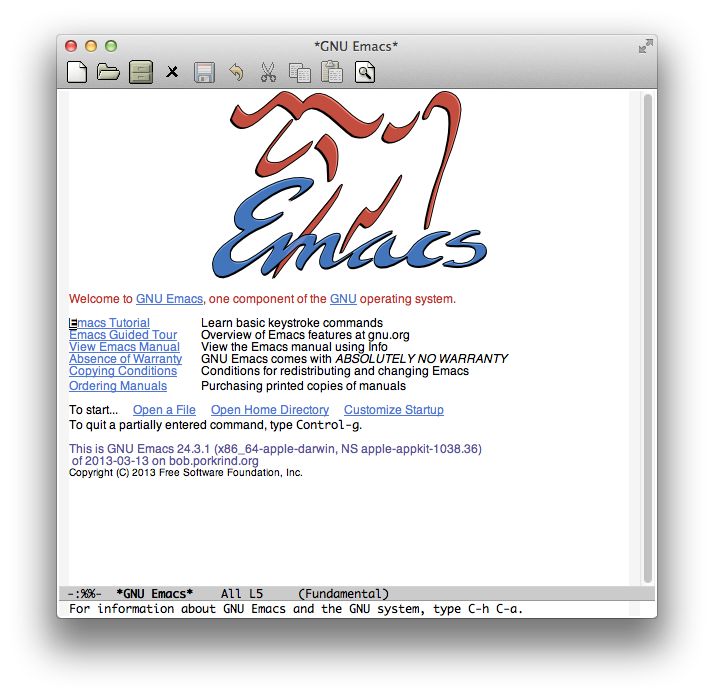A Presentation for GA-Con
- "LISt Processor"
- Second-oldest (by one year, after Fortran) high-level programming language still in use today (invented at MIT!)
- Became popular language for AI research
- Pioneered many important CS concepts
- Common Lisp and Scheme are the two most widely-used Lisp dialects
- Created by Rich Hickey of Cognitect
- Emphasizes "functional programming", i.e., tends away from mutable data, treats program as evaluation of mathematical functions
- Specialized language for dealing with problems of concurrency
- Multi-core processing creates problems with multi-threaded operations... if multiple threads are working with the same data, possible to achieve unexpected and incorrect results
- Clojure takes advantage of multi-core processing power while maintaining data integrity by leveraging its data immutability and its strict rules for data mutations
##Emacs In order to use a Lisp dialect, you have to be running a self-compiling list text editor... if I had realized this earlier in my preparations for this presentation, I would have presented on something else. But I didn't, and I spent three hours yesterday learning Emacs, so now it's time for a presentation within a presentation on Emacs.
- I can barely use this POS
- Normal text editor shortcuts do not work here; it's as if you're writing code in your terminal
- Write your code in buffers
- Evaluate lines of code in REPL
Allow me to demonstrate messing up a bunch of times as I try to navigate Emacs. Good times!
- Clojure integer:
1 "A Clojure string"["Clojure" "Vectors" "Are" "Like" "Javascript" "Arrays"]
(+ 1 2 3 4)
; => 10
(+ 1 (* 2 3) 4)
; => 11
(def name "Rooster Bock Brewster")
(str "This presentation presentated by: " name)
; => "This presentation presentated by: Rooster Bock Brewster"- Operations happen with the following syntax: open parens, operator, operands, closing parens
- Note syntax for nested operations, as well as variable definitions
- variable definitions are generally immutable
(if (= (+ 1 2) 3)
"Jeff's beard is great"
"Kevin's beard is great")
; => "Jeff's beard is great"
(if (= "Yao Wen" "Really cool")
"Jeff's beard is great"
"Kevin's beard is great")
; => "Kevin's beard is great"- First position tells Clojure that it's an if statement
- Second position is evaluated as a boolean (only explicitly falsy values are
nilandfalse) - Third position is the code which is evaluated if the boolean is true
- Fourth position is the code which is evaluated if the boolean is false
- But what if you want to do multiple things upon the boolean's resolution?
(if (= "This presentation" "smooth and flawless")
(do (println "Jeff's beard is great")
"And he worships a lizard-octopus elder god")
(do (println "Kevin's beard is great")
"And he crushes beer pong"))
; => Kevin's beard is great
; => "And he crushes beer pong"The "do" operator can fit several actions within one "position" of the if statement
(def yao-wen "Really cool")
(when (= yao-wen "Really cool")
(println "Yao Wen claims I am skilled in hip-hop dance")
"As a cis-male person of pallor I find this highly offensive")
; => Yao Wen claims I am skilled in hip-hop dance
; => "As a cis-male person of pallor I find this highly offensive"The "when" operator is similar to "if", but only evaluates if the boolean evaluates to true
orevaluates to the first truthy value in a list, or the last value if none are truthyandevaluates to the first falsy value in a list, or if none are falsy, the last value
; VECTORS
(conj [1 2 3] 4)
; => [1 2 3 4]
; LISTS
(def ex-list (list 1 "two" {3 4}))
(nth ex-list 2)
; => {3 4}
; SETS
(hash-set 1 1 2 2)
; => #{1 2}
(def not-uniq [1 1 1 1 1 5 5 5 5 5 7 7 7 7])
(def uniq (set not-uniq))
uniq
; => #{7 1 5}
(sort uniq)
; => (1 5 7) -- note that it's a list nowLet's look at some example functions in a .clj file loaded in Emacs
From what I've seen, Clojure engineers do quite well, so we should all be rich by next week

